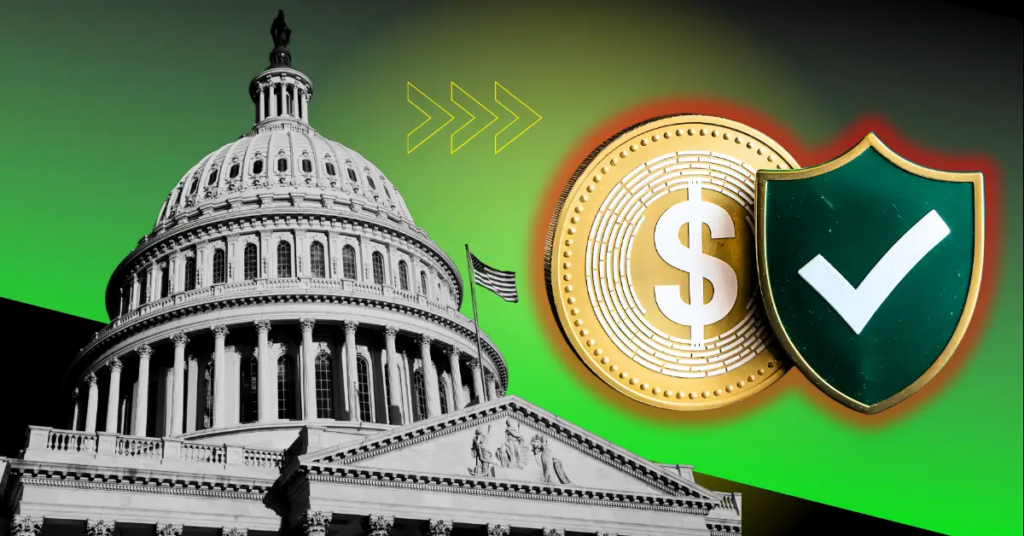Introduction
The U.S. House of Representatives has just dropped a game-changing stablecoin oversight bill, setting the stage for a clear regulatory path for dollar-backed digital currencies. Introduced in early 2025, this move aligns with a wave of crypto action on Capitol Hill, from Senate tax debates to fresh blockchain policies. Dubbed the Stablecoin Transparency and Accountability for a Better Ledger Economy (STABLE) Act, it’s a big step toward balancing innovation and safety in the fast-evolving crypto world. Curious about what this means for digital assets? Let’s break it down!

U.S. House Stablecoin Bill: What’s Inside?

STABLE Act Highlights Unveiled
Led by Rep. Bryan Steil and Rep. French Hill—key players in the House Financial Services Committee—the U.S. House Stablecoin Bill, officially the STABLE Act, brings sharp focus to crypto oversight. Here’s what it covers:
- Tight Alignment with Senate: It mirrors the Senate’s bipartisan stablecoin bill, smoothing out past differences.
- Dollar-Backed Token Rules: Companies issuing these tokens must prioritize transparency and accountability.
- Reserve and Oversight Standards: Issuers face strict reserve requirements, regular reporting, and federal scrutiny—especially non-banks and big players.
Rep. Tom Emmer, a crypto champion, says the House and Senate versions are close enough to hash out quickly, hinting at a unified law soon.
Momentum Builds in Congress

The Senate Banking Committee already greenlit its stablecoin bill, and now the House is stepping up with the STABLE Act. Lawmakers on both sides see 2025 as the year to nail down U.S. House Stablecoin Bill regulations. Meanwhile, Emmer’s reintroduced Securities Clarity Act—teamed up with Rep. Darren Soto—pushes for broader crypto definitions under securities laws. At the DC Blockchain Summit, optimism soared, with August pegged as a deadline for finalizing this crypto framework.
Crypto Policy Expands Beyond Stablecoins

Senate’s IRS and DeFi Push
While the U.S. House Stablecoin Bill grabs headlines, the Senate’s tackling crypto taxes. A Congressional Review Act resolution aims to ditch the IRS’s 2024 DeFi broker reporting rules. It passed both chambers, but Senate rules demand a revote since tax bills start in the House. This dual-track approach shows Congress isn’t just focused on stablecoins—it’s shaping the whole crypto landscape.
Gillibrand’s Call for Bank Safety
Senator Kirsten Gillibrand isn’t sold on unrestricted stablecoins. At the 2025 DC Blockchain Summit, she warned that letting issuers offer yields could siphon deposits from banks. “If small banks lose funds, mortgages and business loans could dry up,” she said, pushing for New York-style strict oversight nationwide. Her stance highlights a tug-of-war: protect traditional finance or unleash crypto’s potential?
How the U.S. House Stablecoin Bill Shakes Markets

Boosting Crypto Confidence
A solid U.S. House Stablecoin Bill could spark big changes:
- Institutional Buy-In: Clear rules might draw banks and firms into compliant stablecoins.
- Clarity for Players: Exchanges and devs get a legal playbook to follow.
- Safer Markets: Transparency and reserves cut risks, steadying crypto’s wild ride.
With the STABLE Act nearing reality, 2025 could be a turning point for digital assets in the U.S.
Balancing Act with Traditional Finance
Gillibrand’s fears aren’t unfounded—stablecoins offering interest could lure savers from banks, shaking up lending. But supporters argue regulated tokens like WYST or USD1 could strengthen the dollar’s global grip. The U.S. House Stablecoin Bill aims to thread this needle, fostering innovation without toppling the old guard.
Conclusion
The U.S. House Stablecoin Bill, through the STABLE Act, signals a new era for crypto oversight. Paired with Senate efforts and broader policies like the Securities Clarity Act, Congress is crafting a roadmap that juggles innovation, safety, and stability. As debates heat up, the stakes are high for crypto fans, investors, and banks alike. Will this spark a boom or a bust? Dig deeper into stablecoins and share your take below!




